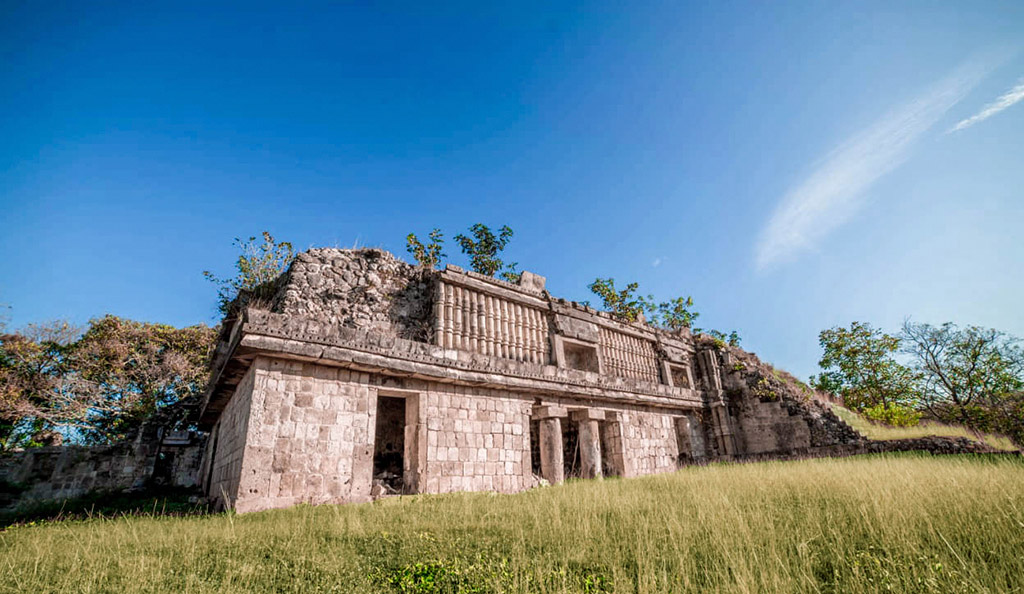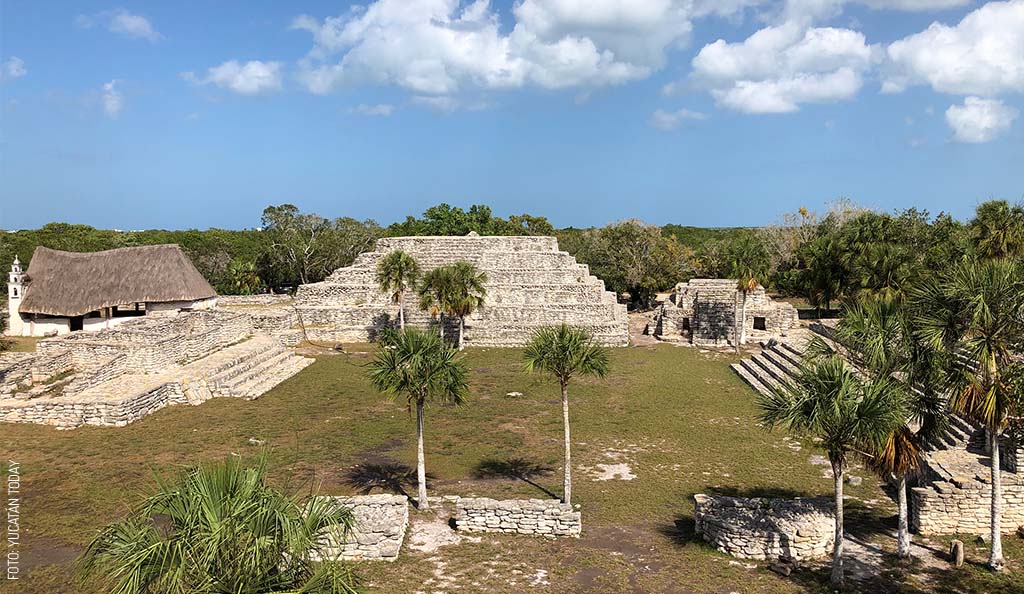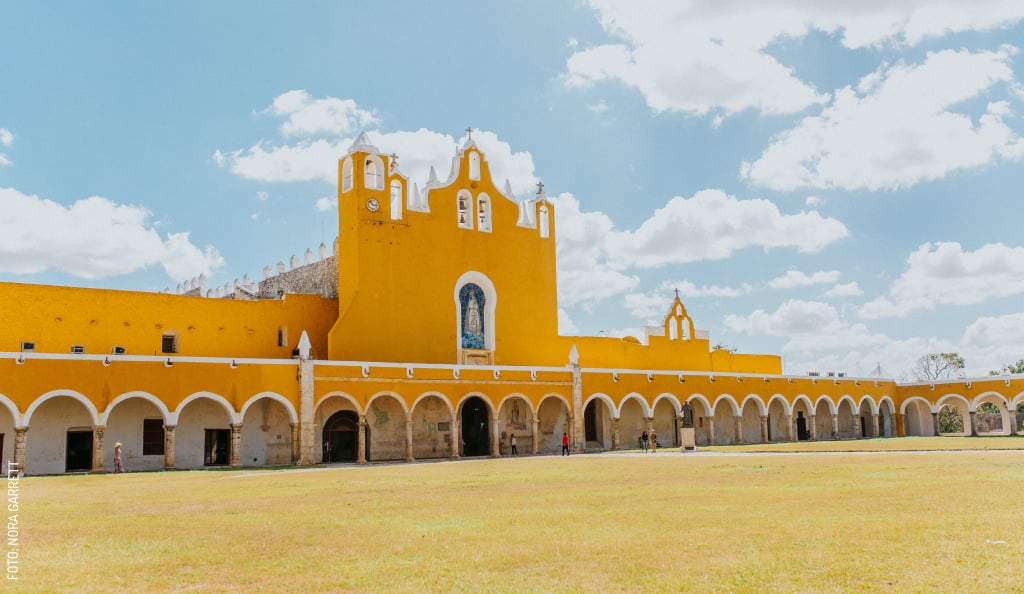
Chacmultún, a Maya Legacy
The Maya archaeological site of Chacmultún (chac = red / mul = mound / tun = stone) is one of the last sites along the well-known Puuc Route, featuring architectural details and constructions reminiscent of the type found at Uxmal, Kabah, and some of the other sites in the area.
Chacmultún, a Hidden Treasure of the Puuc Route
Not everyone’s backyard comes with a piece of ancient history, but for some, having an archaeological site as part of their daily routine is just a way of life. That’s exactly the case for those who must pass through Chacmultún to enter or leave their village. Located 130 km (81 mi) southeast of Mérida, this site is one of the final stops along the Puuc Route. While it may not be as well-known as other archaeological sites in the area, that’s about to change.
A must-visit on the Puuc Route
As I mentioned, Chacmultún is part of the Puuc Route, one of only two archaeological routes in the world declared a UNESCO World Heritage Site. Here, you'll find the distinctive Puuc-style architecture, featuring geometric patterns, columns, and intricate stone mosaics that will leave you in awe of Maya ingenuity. What makes Chacmultún truly unique is the reddish hue of its structures, caused by the presence of microorganisms on the stone slabs. Its name reflects this characteristic, as Chacmultún means “mounds of red stone” in Maya. The entrance fee is $75 pesos per person, with an additional charge of $50 pesos for video recording devices. To reach the site, you must pass through the towns of Canek, Kancab, and Chacmultún.
Exploring Chacmultún
The archaeological site covers one square kilometer and consists of four main groups: Chacmultún, Central, Cabalpak, and Xethpol. Each of these areas offers a unique perspective on the organization and urban development of the Maya civilization. Chacmultún reached its peak between 600 and 1000 CE, becoming the most important city in the easternmost part of the Puuc region. During this period, the city dominated regional trade and is estimated to have housed up to 15,000 inhabitants.
In the following centuries, the city began to decline and was completely abandoned by 1500 CE. It wasn't until 1875 that Chacmultún was rediscovered by Teoberto Maler, a former captain in Maximilian of Habsburg’s army, who later became an explorer and photographer of ancient Maya cities and pioneered the fight for México's cultural heritage preservation.
Chacmultún Group
This is the largest and best-preserved architectural complex on the site. You’ll notice its elevated platform with stairways, which connect the different structures.
One of the most important buildings is El Castillo (The Castle), the largest and best-preserved construction. Its monolithic columns and intricately carved geometric designs not only showcase the exceptional skill of Maya architects but also provide a glimpse into their worldview and way of life. Many of the carvings reflect their deep reverence for water, a central element in their culture. If you take a moment to examine the stones that form the nearby structures, such as the vault at the back, you’ll notice that the voussoirs (wedge-shaped stones in the arches) have a distinctive “boot” shape. This is a unique hallmark of Puuc stone masonry. You can also admire the cornice designs and the creative techniques the Maya used to prevent humidity damage, knowledge that remains relevant today.
If you continue west of the Castle, you’ll find a chultún, an underground cistern the Maya used to store rainwater. Since Chacmultún had no natural water sources, they initially relied on underground cavities that retained water. Over time, they developed this advanced water collection system to ensure year-round access to water.
Walk through Building 3 in this group, and you’ll discover one of Chacmultún’s most fascinating elements: its paintings. Originally, this building had 11 rooms arranged in an L-shape, though only three remain standing today. In one of these spaces, remnants of humanist murals still survive, depicting interactions between different groups. Despite the passage of time, you can still make out some details, including red and blue traces that have endured for centuries. Finish exploring the Chacmultún Group by taking a look at the altar located to the east of Building 3.
Cabalpak
 To reach this group, you first need to pass through the Central Group, where you’ll find the Ballgame Court. Chacmultún is one of the few sites along the Puuc Route that features a Grand Ballgame court. Take a moment to imagine the intensity of these matches, which were far more than just a game—they were sacred rituals where the players, seen as warriors, regarded sacrifice as the highest honor.
To reach this group, you first need to pass through the Central Group, where you’ll find the Ballgame Court. Chacmultún is one of the few sites along the Puuc Route that features a Grand Ballgame court. Take a moment to imagine the intensity of these matches, which were far more than just a game—they were sacred rituals where the players, seen as warriors, regarded sacrifice as the highest honor.
Continue south, and you’ll arrive at Cabalpak, known as "the sunken terrace." Its sloped terrain creates a curious optical illusion, especially for those unfamiliar with the area. Since different sections were leveled, the three main structures in this group might appear as a single building at first glance. The most notable is Building 5, which remains well-preserved and is an excellent spot for stunning photos.
Xethpol
If you're a fan of breathtaking views, Xethpol—which means "severed head" in Maya—is the perfect place to end your visit. It is the tallest structure in Chacmultún, and from its summit, you can enjoy a panoramic view of the entire Puuc region, along with a refreshing breeze after your hike.
Visit Chacmultún
Visiting Chacmultún and any other archaeological site in the Puuc region is a unique opportunity to walk through history, stepping on the same ground that, thousands of years ago, was traveled by astronomers, architects, warriors, master builders, and people just like you and me. Their legacy continues to reveal new knowledge, not only about those who once lived here but also about their lasting impact centuries after their time.
- Maya meaning of "Chacmultún:" Mound of red stones
- Inhabited period of Chacmultún: 300 BCE - 1500 CE (Late Preclassic to Late Postclassic)
- Golden age of Chacmultún: 800 - 1000 CE (Classic and Postclassic)
- Location: 10 km (roughly 7 mi) southwest of Tekax
- Services: None
- Price:
- Federal admission fee: $75 pesos
- Seniors over 60, children under 13, retirees, pensioners, people with disabilities, active teachers, and students are exempt from the federal fee.
- All Mexicans and residents in the country are exempt from the federal fee every Sunday.
- Federal admission fee: $75 pesos
- Hours: Every day, 8 am to 5 pm
- Nearby sites and activities:
- The Magical Town of Tekax awaits with endless options for adventure tourism activities
Photography by Ralf Hollmann and Oscar Góngora for use in Yucatán Today.

Author: Sara Alba
Panamanian with a Mexican accent since 2005. Editorial Assistant, a walking jukebox, and always lurking on social media, in the constant search of hidden gems to visit and share.
¿Enamorado de Yucatán? Recibe en tu correo lo mejor de Yucatán Today.
No te pierdas nuestros mejores artículos y la edición digital cada mes antes que nadie.
Related articles

Maya Archeological Sites
Discover unique Maya archaeological sites in Yucatán, including Ek Balam and Dzibilchaltún. Catch a glimpse of the Maya civilization!
What We Know About the Maya Thanks to Xcambó
Xcambó is the only known archaeological site on the coast of the state of Yucatán. It is also considered one of the oldest, as it began to be...






